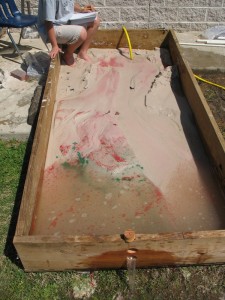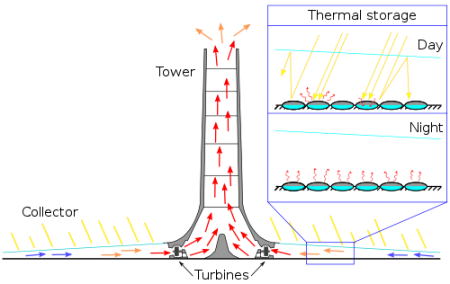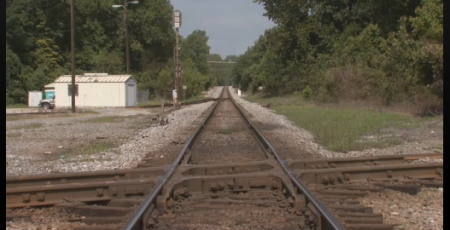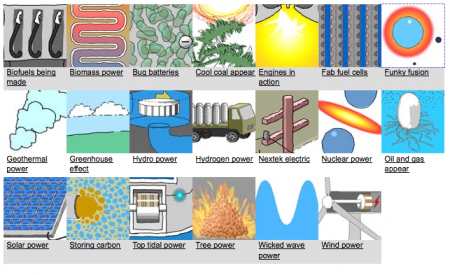Hydrogen is an alternative source of fuel (alternative to fossil fuels), but it can be produced from renewable or non-renewable sources. PBS and Scientific American Frontiers have a nice video on hydrogen fuel. They first visit a lab producing hydrogen fuel cells. The second part of the program visits Iceland is trying to use geothermal energy to create the hydrogen. They also discuss producing hydrogen from solar-electric and algae.
Category: video
Oil traps and deltas in the sandbox

The sandbox was built to be a wave tank so we could look at interference patterns and wave properties. But if you tilt it a little, and put in a few holes on the lower end, you can get sandbox to look at the formation of streams, deltas and the sedimentary layering that traps oil and natural gas.
Using the holes at the bottom end the students started with a low “sea-level”, raised it and lowered it. At the end of the run, they drained all the water and sliced the tank to see the depositional layers in cross-section.
We added red and green sand to try to make marker beds before each change in base level. The marker beds worked reasonably well, but it would have been better to have sand with different densities that could be sorted by the stream flow and depositional environment. It also helps to get the colored sand wet, to make a slurry, otherwise the grains will float on the water.
The shifting lobes of the delta showed up very well (see the animation) and some nice river features showed up as well. What I want to do sometime is to have students build coastlines and have waves erode them away creating typical coastal features.
My students were even able to demonstrate the tank for their presentation, because it really only takes half an hour to get all the features if you know what you’re aiming for.
Sources
The exercise these results are based on is posted as The Geology of Oil Traps Activity.
Methane hydrates for energy
Despite the fact that methane is a powerful greenhouse gas itself and burning it produces carbon dioxide there is currently quite a bit of research on extracting methane hydrates from the sea floor as an alternative to the traditional fossil fuels because there is just so much of it. Discovery Channel has an interesting video on the topic where they burn some methane hydrate ice.
Methane releases from the arctic and sea-floor could also trigger rapid climate change. Recent discoveries suggest that global warming is warming the arctic so much that the permafrost is melting an releasing a lot of methane into the atmosphere. If the arctic atmosphere continues to warm, more methane will be released, causing more warming …. This positive feedback loop would accelerate global warming. Some scientists worry that warmer ocean waters can melt methane hydrates at the sea floor releasing them into the atmosphere in a similar positive feedback loop.
Solar convection towers

Discovery Channel has a nice video on using a large tower, set at the center of a large greenhouse in the dessert, to generate thermal convection to power electrical turbines.
Solar cells
How do solar cells (photovoltaic cells) work? There are very simple explanations, but you can probably find a video with any level of complexity you might want.
This video from the U.S. Department of Energy is fairly general and makes a nice introduction:
This video adds some useful detail.
For even more detail, NASA’s page on photovoltaics is very good, and Scientific American has a neat little interview with Paul Alivisatos that goes into the parallel between photovoltaic technology and photosynthesis.
Simple animations about different energy sources
The UK Science Museum has a set of very simple videos describing how different sources of energy are created and harnessed. They are very simplified but perhaps useful introductions to how things like solar cells work; how oil and natural gas form; what is fusion and how it might be harnessed; how tidal power works etc.
Video games and real war
“It’s going to be a constant question for us as a society and for the military whether or not, as they become more game-like, that creates an effect that makes it easier to kill people in a way that you might not want to make it easier to kill people.” – Clive Thompson on On The Media (2010)
On The Media had one of the most though provoking pieces this weekend that I have ever heard. It was based on the video footage of the tragic killing of two Reuters journalists in Baghdad, and the wounding of two small children in a van that came to rescue the injured, by a US helicopter gunship. The program dealt with the tragedy itself, the question of war crimes and the propriety of Wikileaks in publishing the video.
They also addressed the marked similarities between the video footage and scenes in modern video games. What was most interesting was that the interviewee, Clive Thompson, argued not that video games were becoming too much like war and desensitizing players, but that war is becoming too much like video games.
It’s been generally acknowledged that the further away the person is, the less you can see them, the more they’re just a blip on the screen, the easier it is to pull the trigger. – Clive Thompson on On The Media (2010)
Audio of the piece called “Virtual War” is below:
PBS’s Exploring History in Corinth and Shiloh

Since we just got back from an immersion trip to Corinth, MS and Shiloh, it was very interesting to find out the PBS has a new Exploring history program: Exploring History: Corinth, Mississippi and Shiloh National Military Park. Check your local station (as they say) or you can find the video online.

